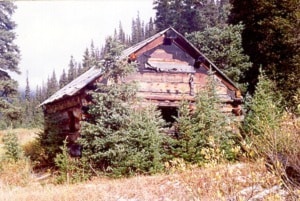An old cabin always catches our attention as we wonder what its life story might be. They are the evidence of much of our past but they are rapidly disappearing as the old structures deteriorate.
The most recent picture, taken in September 1992, shows a miner’s cabin on Sawmill Flat, just off the 1861 pack trail that goes from near Keithley Creek to Barkerville, over the Snowshoe Plateau.
The area got its name when, in May of 1961, a small sawmill was set up on Antler Creek nearby.
Everything needed for the mill came by pack train from New Westminster, according to Fred Ludditt in his 1969 book Barkerville Days.
Antler Creek was the first stream north of the Snowshoe Plateau where gold in great quantities was found. It was so rich that a town developed almost overnight, 1,200 souls worked there and sawn lumber was a vast improvement over logs and whip sawn planks for flumes, rockers, doors and sheds.
R.P. Baylor, the owner, did well as did a later owner I.B. Nason.
J.C. Beedy put in the first store at Antler and is remembered now in Beedy Creek on the Likely Road.
The flow of eager miners, rushing on down Antler Creek and the entire stream from its source in Racetrack Flat to it mouth on the Bowron River, mined for gold.
In much later years, large floating dredges reworked the gravels and removed the town.
The huge waste rock piles are easily seen as you turn off the Cunningham Pass forest road (3100 road) at 14 km at Whisky Flats recreation site and go upstream on Antler Creek.
A cabin on Sawmill Flat was constructed by a Mr. Littler who later worked as a body guard for Billy Barker. Who built the cabin in the picture is not clear.
By 1863, Antler Town had shrunk and there was no need for the mill there, so it was brought to Richfield.
It’s interesting to note that many of the small settlements lasted a long time. A Mrs. Kenvick was post mistress at Veith’s store, north of Keithley Creek, in 1940, that’s roughly 79 years of activity along the 1861 pack trail.
Little remains of this cabin now and the forest is slowly reclaiming the site. Horses don’t run on the course up Racetrack Flat, but the rocks cleared to make the track are visible.
We are rich by these histories.
What will be the evidence of our current lives?
Andy Motherwell is an amateur historian and regular Observer contributor.
